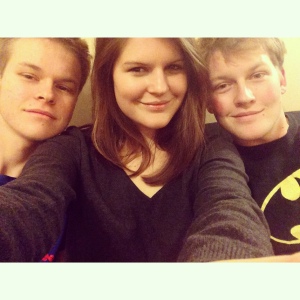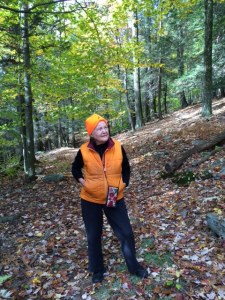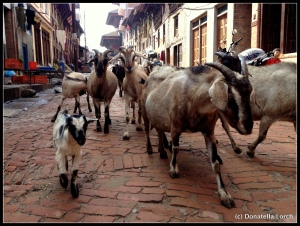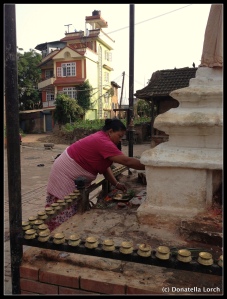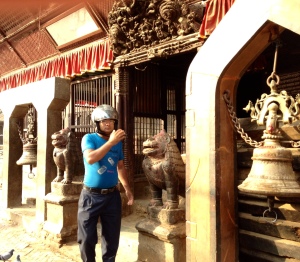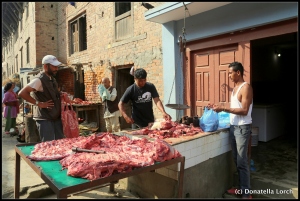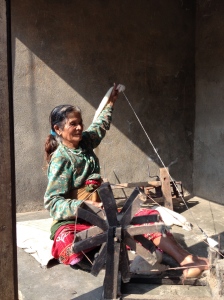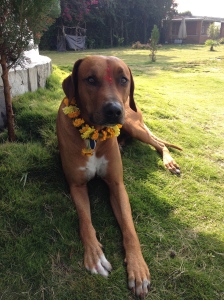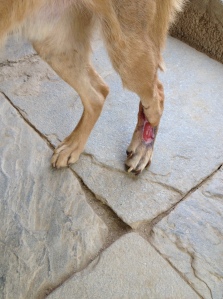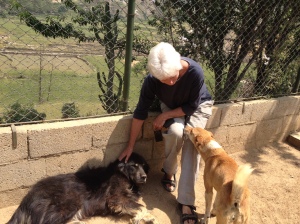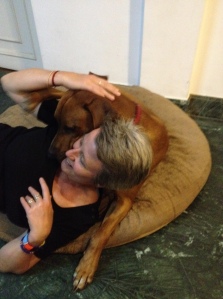
Madeline and Lucas bonding with the “tourist” Sadhus at Pashupatinath, kathmandu. © Donatellal Lorch
Winter has come to the Kathmandu Valley, with what the weather people here say is an unexpected cold snap. But after a year and a half living here, the unexpected is really the new normal. The high mountains have got more than five feet of snow so far this winter, stranding trekkers (rash enough to trek in December). Planes aren’t flying, and motorists in the far East, North and West of Nepal have been stranded for several days on snow-bound roads. And no, there aren’t any warm places to stop for a snack, and there are no nearby motels.
Meanwhile, in the Kathmandu Valley, it’s raining, which means temperatures are dipping to nearly freezing. There is no heat in the houses, and so we wear long underwear, multiple shirts and sweaters, down-filled jackets and fleece hats—inside the house–and sit very close to the fireplace and go to bed with hot water bottles right after dinner. I’ve broken down and bought our Rhodesian Ridgeback, Biko, a winter jacket to help him stop shivering.
As part of my tiny effort at reducing black carbon emissions – Kathmandu ranks as one of the world’s most polluted capitals – I try never to use our diesel generator – which is challenging in a city that in the dry winter months provides its denizens with only about six hours of electricity a day. But we are lucky to be in 2015 as in another few years, if Nepal cannot harness its massive hydropower potential, the valley’s rapidly growing population (4 million now and estimated to reach 15 million by 2045) will consider power grid electricity a rarity.
Kathmandu was originally home to our nine-year-old son, Lucas, Biko and myself—John, my husband and Lucas’s father, spends most of his time in Dhaka, where he works. Here in the valley, we seem recently to have added an adopted family of stray dogs that live outside our gate and grows each week as I deliver daily bowls of steaming rice and left-over meat in the hope that it will help the dogs cope with the nighttime cold.
Living here has been a godsend for me. I write and explore, both physically and mentally. The Kathmandu Valley is a gem of ancient art and living religions that date back to the early centuries of the common era. It has taken me over a year to begin an acquaintance with the dizzying complexities of Nepali and Newar cultures (the Newar were the valley’s original inhabitants). We live just up the road from Khokana, one of the oldest Newari towns in the valley, a place where medieval traditions continue: stables in the ground floor, butchering in the street, morning bathing on the doorstep with a pitcher of water, and lots of sidewalk and street-side activities like rice drying and wool carding on an ancient spinning wheel. I love my weekly runs through Khokana and the neighboring amphitheater of fields that alternate summer rice paddies with winter wheat and potatoes, with many of the villagers walking the paths out into the fields in the mornings to attend to their crops. And where else in the world can one live these days where there is not just one Maoist party, but three Maoist splinter parties fighting one another for supremacy?
Lucas, who before spoke English with a Swahili accent when we lived in Kenay, now has a Nepali lilt, with essential Britishisms such as “dustbin” (rarely seen outside his school) and “tipper truck” (increasingly the most popular and overloaded vehicle in the Valley as road and building construction booms). He is keen on becoming a fighter pilot as well as a Marine Corps engineer. With limited television, he now is addicted to the New York Times videos and to re-runs of Top Gear viewed on my Ipad. Internet videos about aircraft carriers of various kinds are also extremely popular on cold winter days.
John lives in Dhaka, working a grueling schedule in Bangladesh and commuting to his two other World Bank countries Nepal and Bhutan, with side trips to Delhi, Dubai and Washington D.C. Dhaka is one of the few capital cities even more polluted than Kathmandu or Delhi. It is not an ideal family life, but we have worked out a modus vivendi and structure our time together by using Lucas’ school term breaks as a chance to visit the region. In the past year or so, we have been able to visit Vietnam, Cambodia and Malaysia. John lives mostly on planes and even though his commute from Dhaka should in theory be only 1hr10 mins, it has been as long as 11 hours due to weather and technical delays. Kathmandu winter fog, further weighed down by heavy pollution, can close down airspace for hours.
Our Christmas gift to the family is that all six of us will converge from four countries and two continents—all now in winter– somewhere warm. This time, because of the logistics of moving the kids from half way around the world, we are meeting in Thailand. Raising kids while living overseas has recently meant for us longer times apart, as they hit their upper teens and head back to North America for schooling. Interestingly, we haven’t had a family argument in over three years. We speak more about “missing” rather than “wanting.” We laugh more. We make a point of having holidays together and then of connecting over long dinners. The kids have made sure we are geared up to communicate: through FaceTime, Skype, Whatsapp, email and even the traditional landline.
Alex, now 17 and hitting 6 feet, is about to finish high school and has applied to a number of colleges without asking for parental advice or assistance (except for filling out financial forms). From the extended family that sees him on long weekends, we understand that he is incredibly helpful cooking and cleaning. He remains an avid reader of Kant, Joyce, Woolf, Shakespeare and other writer-philosophers as well as the captain of his school’s Ultimate Frisbee team. This summer he showed himself an adept stunt diver, hooking his finger as he leapt through a hoolahoop into a Catskill pond and breaking his writing hand. All this was exquisitely timed, done on a Sunday the day before we headed back to Kathmandu. Three doctors, three casts, two countries and one week later, he was happily teaching Ultimate Frisbee to Nepali school kids with his left hand.
Nico, 20, is a junior in Physics and Philosophy at University of Toronto where he frequently ponders the greater meaning of life, a mental activity that entails long calls with John about the reason for man’s existence. I’d like to say that he chats with me about Quantum Physics but there are those that know that I barely passed high school physics and chemistry. Though he still does not have a Canadian driver’s license (his Kenyan one is unusable outside of East Africa), he has a boat piloting license and does a pilot and tour-guide double on Lake Eerie.
The oldest, Madeline, 22, studies Political Science and will graduate from the University of Toronto in the spring of 2015, with some trepidation about what will happen next. (I am sure that many of you have been there—I certainly have!) Madeline and I are the outliers in the family, as we don’t like Maths or science and enjoy the occasional People magazine. Mado is also the one who keeps the family together. With an unfailing self-deprecating humor, she makes sure she stays in touch with everyone on a regular basis. John, Lucas and I are trying to convince her to come to Nepal for a year. Who wouldn’t want to drive on death-defying roads, live without heat in winter, get bitten by leeches during the monsoons, and wake to the rattling bells that summon Shiva at 5:15 in the morning?
The magic of Nepal works in mysterious ways. Even the calendar overwhelms. There are 50 national holidays a year (I believe including Christmas) and more than a handful of New Years celebrations. If Madeline comes, she will have a lot of time off. Nothing is ordinary here. Nothing is what it seems.







